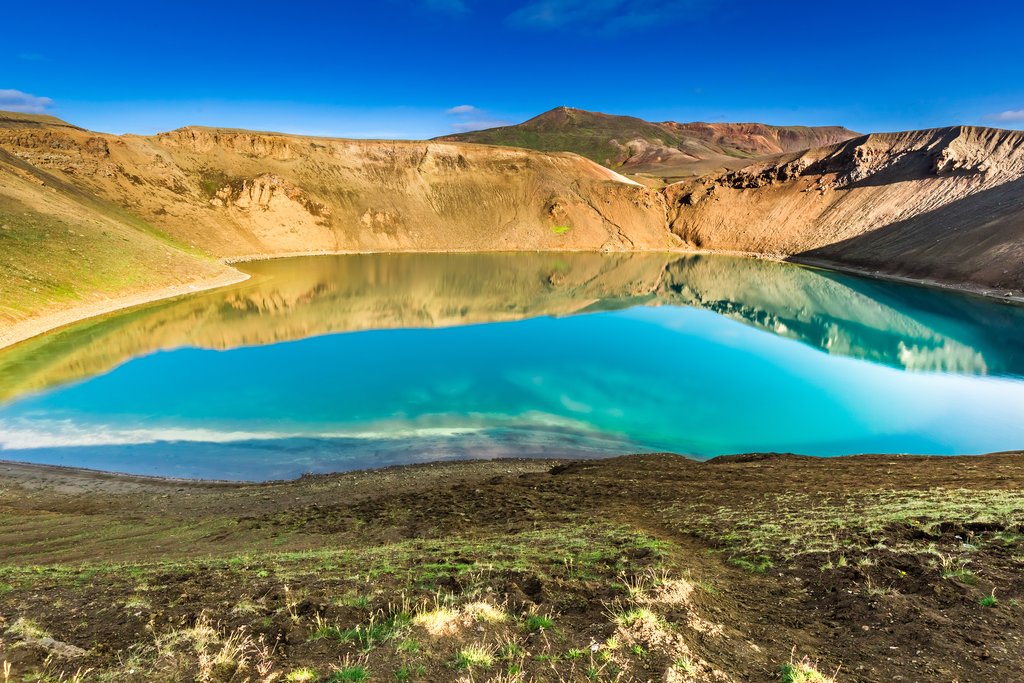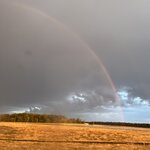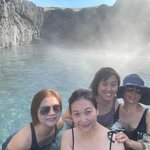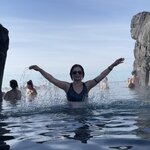Highlights
- Start the road trip with a hike to the top of Glymur Falls (Iceland's tallest)
- Take a car ferry to the Westfjords for a memorable travel experience
- Hike to geothermal pools, lava fields, and volcanoes around Lake Myvatn
- Drive along Iceland's lesser-known eastern fjords where few travelers venture
- Get to the clifftop above Dyrhólaey Beach for views of the famous arch
Brief Itinerary
| Day | Highlights | Overnight |
|---|---|---|
| Day 1 | Arrive in Reykjavik, Explore Downtown | Reykjavik |
| Day 2 | Glymur Falls & Snaefellsnes Peninsula | Snæfellsnes Peninsula |
| Day 3 | Ferry From Snaefellsnes Peninsula to the Westfjords | Patreksfjörður |
| Day 4 | Southern Westfjords: Látrabjarg & Dynjandi | Isafjordur |
| Day 5 | Isafjordur or Hornstrandir Hiking | Isafjordur |
| Day 6 | Drive from Isafjordur to Akureyri | Akureyri |
| Day 7 | Godafoss, Whale Watching & Big Waterfalls | Lake Myvatn |
| Day 8 | Geological Wonders of Lake Myvatn | Lake Myvatn |
| Day 9 | Scenic Eastern Fjords: Seydisfjordur to Djúpivogur | Djupivogur |
| Day 10 | Jokulsarlon Glacier Lagoon, Diamond Beach & Skaftafell | Kirkjubæjarklaustur |
| Day 11 | Waterfalls, Black Sand Beaches & Golden Circle | Golden Circle |
| Day 12 | Golden Circle to Reykjavik, Blue Lagoon, Departure |
Detailed Itinerary
Day 1: Arrive in Reykjavik, Explore Downtown

Welcome to Iceland! Upon arrival at Keflavík International Airport, you'll pick up your rental car and drive 30 minutes into Reykjavik. Since many international flights land in the early morning hours, you'll likely want to start your adventure with a hearty breakfast. There are several café and restaurant options in the city center that open early.
From here, you'll have the rest of the day to explore the world’s most northerly capital city.
Things to do in Reykjavik:
- Walk through Reykjavik’s compact downtown area and check out the unique street art scene.
- Head to the waterfront to see the Sun Voyager Sculpture and Harpa Concert Hall with its cool glass architecture.
- Visit Hallgrimskirkja church on the hill and take the elevator to the tower for panoramic views of the area.
- To escape inclement weather, consider visiting a few museums such as the Northern Lights Center, the Saga Museum, the Marine Museum, or the Whales of Iceland Exhibition. You can also join a whale watching tour from the Reykjavik harbor, and snack on a world-famous hot dog at Bæjarins Beztu Pylsur.
In the evening, enjoy a variety of top-tier fish restaurants and Reykjavik’s nightlife.
Day 2: Glymur Falls, Borgarnes & Snæfellsnes Peninsula

After breakfast in Reykjavik, you'll pack up the rental car and head north to experience Iceland's west coast and the Snaefellsnes Peninsula. Both of these areas see fewer visitors compared to the Golden Circle and south coast and will provide you with a bit more time to take in the sites at your own pace.
First, stop for a hike at Glymur Falls, Iceland's tallest waterfall (2 hours out and back). You’ll hike a trail beside a narrow canyon which makes for some great photographs.
Continue on your drive towards the peninsula and stop in Borgarnes where you can learn about the Settlement age of Iceland at the Settlement Center, or simply walk along the shore path near the water. If you have extra time, make some stops at the other quaint historical towns like Reykholt and Hvanneyri.
Once you get to the peninsula, head for the Gerðuberg Basalt Cliffs, where unusual basalt columns rise up out of the earth. Park the car and walk around exploring and getting a closer look. Next, walk through the start of the Budhahraun lava fields on the coast, covered in moss or snow depending on the season.
Keep driving until you get to the village of Hellnar where you can stop for dinner. Near the waterfront, look for a small café with a nice setting that serves delicious fish soup.
Day 3: Ferry to the Westfjords

If there's time this morning, you can finish exploring any sites that you may have missed before driving to Stykkishólmur where you'll catch a 3-hour ferry north to the Westfjords. Keep in mind that departure times vary and are limited during the winter season, but you can also make the 3.25-hour drive instead.
If there's time while you're in Stykkishólmur, consider a stop by the Volcano Museum and enjoy some fresh mussels for lunch by the harbor.
When you arrive by boat in the Westfjords, continue driving to the town of Patreksfjörður where you'll spend the night.
Chat with a local specialist who can help organize your trip.
Day 4: Southern Westfjords: Látrabjarg & Dynjandi

Before heading out for today's adventures, you may want to pick up picnic supplies since there won't have many options until you arrive in Isafjordur.
First, you'll drive to the southwest tip of the Westfjords and start your day with a hike along the edge at the Látrabjarg Bird Cliffs, with incredible views over the waters below.
On your drive back towards Patreksfjordur, consider another detour to Rauðasandur, a red sand beach, which stretches as far as the eye can see. Much of this drive is on gravel roads so prepare for slower speeds. As you head north, stop at the Gardar BA 64 Shipwreck, beached on side of the road and walk around the ship.
Now you'll take Route 62 to Route 60 and head to Dynjandi waterfall. The drive up to the ridge has some switchbacks and is quite bumpy in places. As you reach the top, you will have incredible views in both directions, and for the whole drive down to the fjord near the falls. Park the car and walk around the site's several waterfalls that sit below the massive Dynjandi waterfall. If the weather is nice, this is a great spot for a picnic amongst this beautiful fjord setting.
Finish your drive through Iceland’s longest tunnel, arriving in Isafjordur in the late afternoon. While in town, visit the Isafjordur Maritime Museum, join a cultural and historical walking tour of the town, or eat all the fish you ever wanted at Tjoruhusid, named the best seafood in Europe a few years back.
Day 5: Isafjordur & Hornstrandir

Today, you'll wake up in Isafjordur—the heart of the Westfjords and the region’s largest town. This is a great home base while you're in the area and a pleasant town for a stroll.
Some options for how to spend your day:
- Hike up the sides of the mountains in Isafjordur to see the fjords below.
- Take a boat ride and hiking tour of Hornstrandir Natural Preserve (see below for more info), one of the most remote and scenic areas of Iceland.
- Take a kayaking trip in the calm fjord or paddle all the way to Vigur Island to see exotic birds and sea life.
- Rent mountain bikes and cycle around the avalanche barrier of Ísafjordur. There's an off-road tour with varying levels (including beginner tracks) in the Icelandic "forest" over avalanche walls.
- Go horseback riding through the lush Sandá Valley where you can experience the Icelandic countryside and get views of the "Westfjords Alps".
Hornstrandir Nature Preserve: This is an area of magnificent beauty and wildlife, with sheer basalt mountains stretching from the sea to the sky divided by deep fjords, alcoves, and valleys. At the coastline, the relentless power of the ocean has molded towering sea cliffs, richly populated by birds, while alcoves are home to an abundance of seals. Inland, the crawling glaciers of the last ice age have hewn ancient mountain passes and lakes where the arctic fox wanders in its natural environment.
Day 6: Scenic Drive from Isafjordur to Akureyri

Today involves a lot of driving, although the areas are very scenic. If you want to stretch your legs a bit and have a nice view over Isafjordur, start the morning with a hike up to Trolls Seat for one last view back down on Isafjordur before taking a scenic drive along the fjords. You'll then continue through the Westfjords headed south to rejoin the Ring Road heading east towards Akureyri.
The north coast of Iceland may be the country’s best-kept secret. While crowds of tourists populate the south coast and Golden Circle, visitors here can enjoy the beautiful landscapes and wonderful volcanic areas all to themselves. A few stops to keep in mind on your drive:
-
Icelandic Seal Center in Hvammstangi (10 minutes off the Ring Road): This area is also home to one of the largest seal colonies in Iceland. Look for several sea watching spots along the coast a bit north of here.
-
Hvítserkur, “white shirt” basalt troll (add an hour to your drive): Close to the shore along the Vatnsnes peninsula is the black and white rock formation known as Hvítserkur—a troll who, according to the legend, was caught in the sun and turned into stone. While it's a nice sight from above, you'll also find a trail leading down from the parking lot.
- Varmahlíð: Stop in this small town, where Route 1 and Route 75 intersect (an hour before Akureyri). Here you can visit the Glaumbær Farm and the Víðimýrarkirkja Turf Church. This is a great way to experience the turf houses and to see how Icelanders used to life. The turf church, built in 1834, is one of the only remaining preserved turf churches in Iceland.
When you arrive in Akureyri, Iceland’s second largest city of 18,000 people, get out and walk around town. Be sure to check out the thriving restaurant, cafe, and bar scene, and visit the Akureyrarkirkja church on the hill. With more time, follow the footpath along the calm old harbor to see more of the picturesque fjord.
Day 7: Godafoss, Whale Watching & Waterfalls

Spend your morning with breakfast in Akureyri before you get on the road (Route 1) towards Husavik and Lake Myvatn. Be sure to take a look back towards Akureyri from the other side of the fjord; you can see the mountains behind the town and it makes for a great photograph.
After about 35-40 minutes on the road, you will see Route 85 to the left for Husavik. Despite this sign, stay on Route 1 for another couple of minutes to reach Godafoss (you will head to Husavik after this detour).
When you arrive at the “Waterfall of the Gods”, hike a couple minutes to see Godafoss up close, or take a longer walk around to see it from multiple perspectives. The waterfall was named when Iceland converted to Christianity in 1000. Legend says that when Þorgeir Þorkelsson (local chieftain and law speaker) made the tough decision to convert the country from the old Nordic gods to Christianity (in order to prevent war), he threw the old gods into the falls to symbolize the change to the new era.
From here, you'll continue back to the Route 1/Route 85 split and drive another 35 minutes to Husavik, the whale watching capital of Iceland. Unlike in other regions where you must set sail to find whales, Husavik often has whales, porpoises, and seabirds close to the harbor. You can join a tour on newer, carbon-neutral ships that are quieter (nicer for whales) and don’t pollute the environment (nice for everyone). We recommend North Sailing, right on the harbor, and the entire building, restaurant, and café was made from recycled wood). Also, check out the whale museum and the church by the harbor.
From here, head to Dettifoss, Europe’s most powerful waterfall. Take a 15-minute hike upstream along the basalt cliffs and you will encounter another giant: Selfoss. You can approach from either the east or west side of the river (there are two roads): The road on the west is paved, while the one on the east is gravel. Both sides offer nice views of the waterfalls, but you have a nicer view of the full canyon from the east.
Continue driving to Lake Myvatn and spend your evening relaxing in the Myvatn Nature Baths—the North's equivalent of the Blue Lagoon, but with fewer people, cheaper prices, and better views. You won’t find all the spa extras that you do at the Blue Lagoon, but you will a few large geothermal pools, a sauna, and a steam room. You can enjoy views down over the lava fields and the craters around Lake Myvatn as you sit in the mineral water.
Day 8: Geological Wonders of Lake Myvatn

The area surrounding Lake Myvatn has the highest concentration of volcanic and geothermal sights in Iceland. In one day you can explore a plethora of pseudocraters, rock formations, lava fields, and volcanic craters.
The following sights are listed roughly in order as you would approach from the western side of the lake driving counterclockwise.
-
Skutustadir pseudocraters: These pseudocraters were formed by when hot lava flowed over the wet marsh area causing steam explosions. Take an easy walk among many pseudocraters on the shores of Lake Myvatn and loop around the smaller lake Stakhólstjörn. You can hike up to a few of them or just walk around them all. Enjoy nice views across the lake where you will see steam rising from the geothermal areas and other volcanic craters in the distance.
-
Dimmuborgir lava formations and “the Church”: Take a walk beneath large, strange, contorted lava formations caused when lava flows cooled. You can see the start of the formations here or hike the small loop in 15 minutes. Or, walk the bigger loop (2 miles) where you will see Kirkja (“The Church”), a natural lava formation that resembles a vaulted church arch, and a nearby cave a bit further.
-
Hofdi rock formations: A little past Dimmuborgir you will see a small turnout for Hofdi. You could spend anywhere from 15 minutes to over an hour here walking the wooded trails that take you to some very unique rock formations in the lake.
-
Hverfjall cinder cone and crater walk: The volcano known as Cinder Cone is hard to miss from anywhere around Lake Myvatn. Climb up the side for a great view of the surrounding area where you can see the Skutustadir Pseudocraters and steam from the Myvatn Nature Baths and Hverarond Geothermal area.
- Hverarond mud pits and steam vents: As you leave Lake Myvatn heading east, your first detour is the Hverarond geothermal area. Here you can walk around various bubbling mud pits and steam vents, admiring the interesting red and orange colors. Exploring the entire area takes from 30 minutes to an hour.
Just after Hverarönd, you will see a turnoff for Krafla/Viti. Take the road and drive 10 minutes for these attractions:
-
Krafla/Viti crater: If you drive past the Krafla power station (also worth a stop), you will find the Viti crater, part of the Krafla volcanic system. This crater is filled with a bright blue lake; on a sunny day, this makes for a great photograph.
- Leirhnjúkur lava fields and geothermal area: Explore the Leirhnjúkur area and you will think you were on another planet. After a 10-minute walk, you will arrive at some steam vents. You can hike a big loop in an hour to see all the highlights, or stick to the first sights along the wooden path
Day 9: Myvatn to the Eastern Fjords

Many people tend to skip right past Iceland's East Fjords, making a beeline from Myvatn to the south coast. With the extra time, though, as this trip allows, you can treat yourself to some of the most scenic and remote coastlines in Iceland with a night in the picture-perfect Scandinavian town of Seydisfjordur.
In this region, you will find lots of beautiful calm fjords, outdoor activities, and small towns at the bases of large mountains. You can even kayak through the fjords, or (for a longer trip) take a ferry to either the Faroe Islands or Denmark.
Here are ideas for scenic day hikes:
-
Hengifoss & Litlanesfoss: Take a 20-minute detour (40 minutes there and back) and hike until you arrive at Hengifoss waterfall, passing Litlanesfoss on the way. These spectacular waterfalls are framed by huge basalt columns and make a great activity for those who prefer to escape the larger crowds in the south. During early summer, you may also spot some puffins in the area.
- Seydisfjordur: After a 30-minute drive over the mountain pass, you will be welcomed with amazing views of the fjord, below. Once in Seydisfjordur, you can hike several trails to waterfalls (two are fairly steep but they only take 5-10 minutes each), walk inside cool sound sculptures, visit a troll church, and explore the artwork and sculptures around the city. If you're looking for a longer hike, head to the northern side of the fjord and hike past several waterfalls continuing all the way to the top (Vestdalsvatn).
Day 10: Jokulsarlon Glacier Lagoon, Diamond Beach & Skaftafell

Today, you'll depart Seydisfjordur in the morning and continue southwest along the Ring Road to Jokulsarlon Glacier Lagoon, about 4-4.5 hours away. Here are some attractions in the area:
-
Diamond Beach: At the Jokulsarlon Glacier Lagoon, you’ll get the chance to see one of the most unique sights in Iceland: icebergs floating out to sea and beached on the black sand. Climb the hill for a better view of the entire area or follow the river under the bridge to the ocean for smaller icebergs along the black sandy shores of "diamond beach" where waves crash against them. It’s quite the sight! You may be fortunate to see seals, porpoises, or small whales that sometimes hang out in the lagoon or near the shore.
-
Fjaðrárgljúfur Canyon: The rock formations in Fjadrargljufur Canyon look like they’re from another world. There is a trail less than a mile from the parking lot along the ridge of the canyon where you will find some amazing viewpoints where the river curves around this strange rock cliffs. You can admire the views the entire time and go as far as you like.
-
Skaftafell & Svartifoss (optional ice-caving & glacier walks): You could spend several days hiking all the trails around Skaftafell. If you’re short on time, the most popular hike leads to Svartifoss, a thin waterfall surrounded by columns of basalt. The hike is around three miles long (weather dependent) and offers great views alongside the river and towards the ocean in the distance. If you like, you can join an ice cave/climbing tour or glacier walking tour based here.
-
Fjallsárlón Glacier Lagoon: A few minutes before Jokulsarlon, you will find another Glacier Lagoon about 10 minutes from the parking lot. Here you are much closer to the glacier than at Jokulsarlon, and you’ll have better views of all the cracks and crevices.
- Hof: A quick trip off the main road will bring you to Hof's turf church. The practice of covering the roof with turf dates back to medieval times throughout Europe to protect from the harsh weather.
When your adventures are complete, drive to the town of Vik for the night, which has several tourist-friendly conveniences like restaurants, cafés, and even a large outdoor gear shop.
Day 11: Waterfalls, Black Sand Beaches & the Golden Circle

After breakfast at your hotel, you can re-connect to the Ring Road heading west and spend the day enjoying popular highlights along Iceland's south coast. The section between Vik and Selfoss is full of cool sites and destinations and is quickly becoming one of the most beloved areas of Iceland. Leave the crowds behind by hiking further on the trails away from the parking lots. There is a lot to see.
Near Vik, along Route 1, you will see a turnoff for Reynisfjara Beach, past the town's iconic red church as you drive towards the water. This black rock beach (not as fine grain as the one in Vik) is most famous for the Reynisdrangar Columns, huge basalt hexagonal columns rising up out of the sand. Walk around the cliffs to the left as you face the ocean and you will find a couple of large caves as well.
Further along the route is Dyrholaey, and there are two parking lots from which you can see the famous arch. The one high on the hill has a better view. Take the bumpy dirt road to your right as you enter. From the top, you will also see a lighthouse and great views looking farther west along a black sand beach that reaches as far as you can see. Look for rare birds (and perhaps even puffins) flying around—they nest along the cliffside.
Also along Route 1, you will find the powerful Skogafoss Waterfall. This marks the beginning of the 16 miles (26 km) Fimmvörðuháls Trail, which ends in Thórsmörk. You can admire the waterfall from the bottom (a short walk from the parking lot), or if you are up for it, find the stairs to the right and climb up for a different perspective. At the top, walk along the canyon to see some more waterfalls along “waterfalls way” before turning around (note: depending on snow conditions this may not be possible).
Continue driving west to Seljalandsfoss waterfall, which you can walk behind (the ground is uneven in a few places but there are stairs on one side). Standing in a cave under the cliff you will see the water come roaring down in front of you. Pay attention to the direction of the wind, or wear a rain jacket (or both!) You will find two smaller waterfalls to the right if you are looking from behind the waterfall.
As you leave the South Coast and head towards the Golden Circle Route, consider an evening stop at the Secret Lagoon (Gamla Laugi) in Flúðir, where warm geothermal water flows from the rocks. It’s a great way to spend your last night on this epic trip!
Day 12: Golden Circle, Return to Reykjavik, Depart

It's time to say farewell to Iceland! Depending on your departure time, you can see some more sites before driving back to Reykjavik. In fact, it's better to start early to visit attractions in the Golden Circle before the crowds and buses arrive when you’ll have these magnificent places all to yourself.
At Gullfoss (“Golden Falls”) you can walk along a few different paths to see the tremendous falls from different angles and perspectives. You’ll want to spend some time here admiring the incredible amount of water that flows over the edge every second.
Next, continue to the Geyser geothermal area where Strokkur geyser shoots into the sky like clockwork every 5-10 minutes. In between eruptions walk around the hot pools, steam vents, or climb the small hill above it all for a great view.
End your tour of the Golden Circle Route at Thingvellir National Park and learn about the traditions of the old Icelandic Parliament that met each summer at Law Rock. Walk between the giant rock fissure where the tectonic plates meet. At the visitor center, you can learn more about the history and geology with its numerous multimedia displays.








